

L
227 results
Light fuel oils or diesel oils are high value distillates that have traditionally been used to fuel diesel engine power plants, both for stand-by operation and baseload applications.
Light tubes (also known as light pipes or tubular skylights) are physical structures used for transmitting or distributing natural or artificial light for the purpose of illumination, and are examples of optical waveguides.
Deuterium-depleted water is water which has a lower concentration of deuterium than occurs naturally on Earth.
A light-emitting diode (LED) is a semiconductor light source that emits light when current flows through it.
A hole cut in any member to reduce weight.
The process of transferring cargo from a tanker to another ship. Also discharging a part of cargo into a lighter to reduce the vessel draft so it can then get alongside a pier.
A small barge for carrying cargo between ship and shore.
Carriage of goods by lighter and the charge assessed therefrom.
The loading condition with the ship on even keel, without cargo, with 10% stores and fuel remaining and in the case of a passenger ship with the full number of passengers and crew and their luggage.
Solid towers which, in the day time, serve as landmarks, and by night exhibit strong lights. These lights vary, so that navigators may recognise the coast they are approaching.
The lighting of crew spaces should facilitate visual task performance and facilitate the movement of crew members in the space and aid in the creation of an appropriate visual environment.
Lighting control systems are employed to maximize the energy savings from the lighting system, satisfy building codes, or comply with green building and energy conservation programs.
Lightning is a naturally occurring electrostatic discharge during which two electrically charged regions in the atmosphere or ground temporarily equalize themselves, causing the instantaneous release
Lightning and Earthing protection systems are essential for the protection of humans, structures, protecting buildings from mechanical destruction caused by lightning effects and the associated risk of fire, Transmission lines, and electrical equipment from electric shock and overcurrent.
A lightning rod (US, AUS) or lightning conductor (UK) is a metal rod mounted on a structure and intended to protect the structure from a lightning strike.
Photodetectors, also called photosensors, are sensors of light or other electromagnetic radiation.
The lightship is a ship complete in all respects, but without consumables, stores, cargo, crew, passengers and their belongings and without any liquids on board except for machinery and piping fluids, such as lubricants and hydraulics.
The mean draught of an empty vessel.
The mass of the ship in metric tons without cargo, fuel, lubricating oil, ballast water, fresh water and feed water in tanks, consumable stores, passengers and crew and their belongings.
Estimation of lightship mass is one of the most important tasks when a new ship is designed. In the preliminary design stage, the lightweight can be derived from the masses of a parent ship.